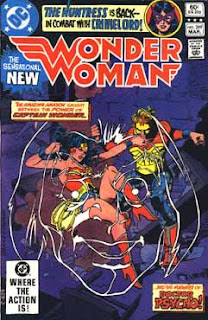I'm reading DC Comics' output from January 1980 (cover date) to Crisis! Today, I'm looking at the comics at newsstands on the week of December 3, 1981.
Arak Son of Thunder #7: Thomas apparently wasn't up to writing chores this month as he's "plotter," and Conway and Barr are "scripters." Colon/Rodriquez still do the art. Arak and Valda end up in Rome seeking help from Pope Hadrian. He doesn't know much and suggests they go to Byzantium. They also meet the Wandering Jew and discover a subterranean people, the descendants of the followers of Pope Ursilus (presumably a standin for Antipope Ursinus give the years. Maybe just a typo?) who are followers of the mad, Black Pope. Arak is like someone's pseudohistorical D&D campaign.
DC Comics Presents #43: This is a fun issue by Levitz and Swan. Mongul takes Superman captive as he menaces Earth with the Sun-Eater, and Jimmy Olsen summons the Legion of Super-Heroes to help--the issue reminds us of Jimmy's history with the Legion. It also creates so tension in that the last time the Legion tangled with the Sun-Eater, Ferro Lad had to sacrifice himself to do it. Wildfire does here, but "sacrifice" is much less permanent for a guy made of energy, in fact it's turned into an end of the issue joke. Swan's stiff, more normally proportioned Mongul leaves a lot to be desired.
Ghosts #110: There isn't much worthwhile in this issue. There's a weird intro that promises "The Shattering Secret of Squire Shade" and then doesn't deliver. Unless the secret is that his carriage turns into a sleigh and his horses into reindeer at midnight on (presumably) Christmas? Anyway, Levitz and Gonzales present a vaguely Christmas story where toys commanded by an electronic device take revenge on a mean store owner. Then Kelly and Trinidad expect us to side with TV Network execs (I guess) as they plot and carry out the murders of every critic in the country after one of their fellows commits suicide following bad reviews. In Kelly's second attempt he's aided by a Paris Cullins who hasn't yet developed his distinct style for the story of a family plagued over the generations by the spirit of a cruel ancestor who is given a chance to walk the Earth again by replacing his doppelganger descendants.
Justice League #200: This is an issue fondly thought of by many, and I see why, but it's not my favorite of this Conway run. It does have an all-star cast of artists, though: Perez, Broderick, Kane, Infantino, Bolland, and Kubert. It riffs off the Appellaxian invasion from the origins of the JLA but adds the twist of a portion of the story where the newer League members must fight the original ones. It's got that hero vs. hero action, teams splitting up--all the classic superhero tropes.
Weird War Tales #109: This issue has a great cover to me. Kanigher replaces DeMatteis on the Creature Commandos and his characterization and dialogue is more consistent with the teams' origins, but at least this first part of the story has a bit less of the "war is hell" aspect of Dematteis' yarns, and he uses a lot more bombastic, Marvel style alliteration. Spiegle's art is probably more consistent with better visual storytelling than what we've got previously, but he doesn't really have a flair for monsters. Kashdan and Zamora follow-up the Commandos with the story of robots used as weapons in futuristic war, who wind up manipulating humans into staying in a continuous state of war to prolong their existence.
Kanigher and Hall/Celardo present an unusual War That Time Forgot tale by moving Circe to Dinosaur Island and having her turn hapless G.I.s into dinosaurs. Finally, Kanigher and Randall present a short, and obvious story about WWI soldiers fighting in a graveyard and dying in the same open grave.
Wonder Woman #289: True to form for Thomas, this issue re-introduces the Golden Age villain Dr. Psycho (though maybe we saw him briefly the issue before). This creates a bit of a continuity glitch, as Psycho had a few appearances in the 60s, starting in the nebulous period between the Golden Age and Silver Age continuity. These have been retroactively deemed appearances of this Dr. Psycho, but the original Who's Who lists this as his modern first appearance. Anyway, Psycho siphons ectoplasm from Steve Trevor and becomes Captain Wonder. The misogynist villain who is literally kind of a mental parasite is rife for modern use, and I think Grant Morrison made good use of him in this context in Wonder Woman Earth-One. Anyway, Silver Swan also makes an appearance at the end of this issue, promising an even bigger conflict next month.
The Huntress backup by Levitz and Staton sees her battling the Crime Lord, who's a crime boss really into the SCA--or at least wearing armor and carrying Medieval weapons.











2 comments:
Dr. Psycho ended up as a major supporting character in the Harley Quinn animated series, mostly as a punchline for his misogynist personality (he gets banned from most villain associations for calling Wonder Woman the "c-word."
"Arak is like someone's pseudohistorical D&D campaign."
Honestly, that was a big part of what I liked about the book.
Post a Comment